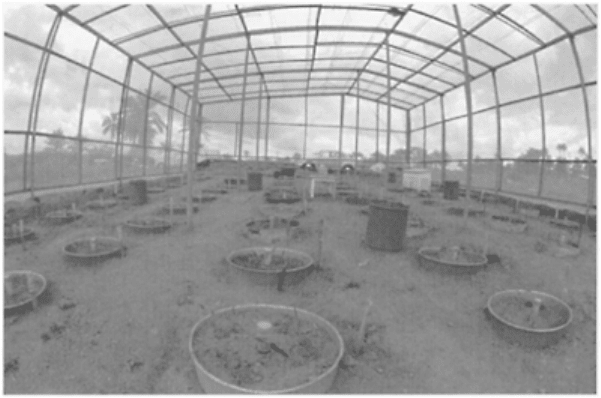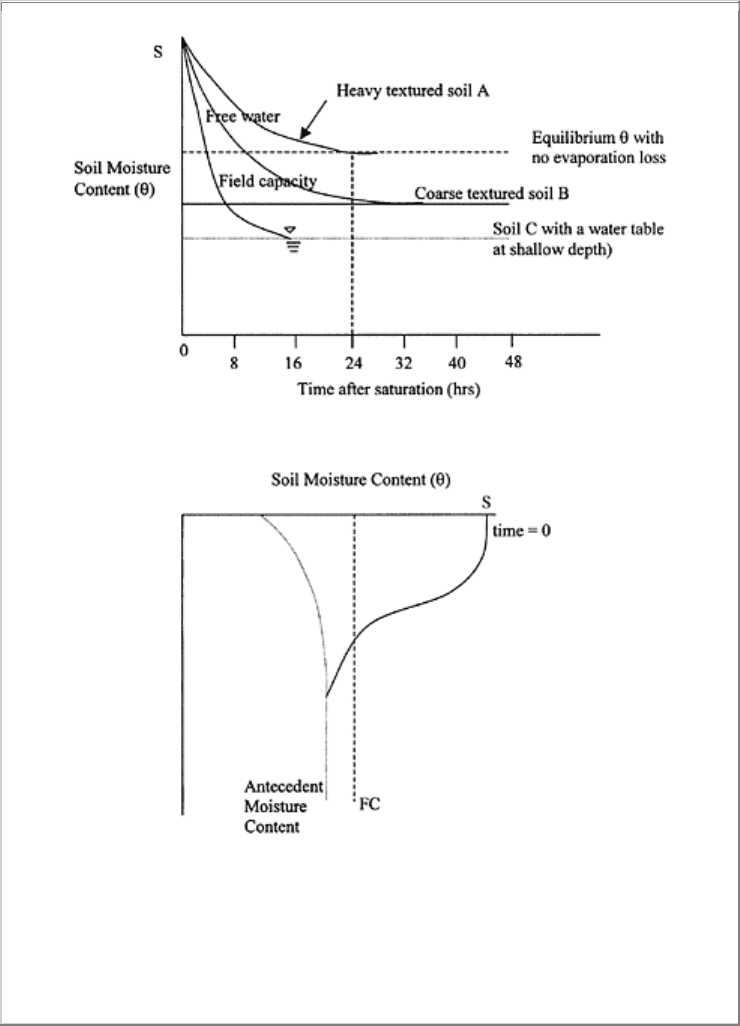Lal R., Shukla M.K. Principles of Soil Physics
Подождите немного. Документ загружается.


FIGURE 9.24 A battery of drainage
lysimeter (a) with a trench to collect
seepage; (b) an underground weighing
and seepage collection facility.
5. Draw up a table or a nomograph comparing different units of measuring water
capacity and flux, and compute conversion factor to change from one unit to another.
6. Calculate the height of capillary rise in a soil pore of 50 µm inner diameter in winter
(0°C), spring (10°C), early summer (20°C), and tropics (40°C).
7. Compute the pressure difference at the air-water interface in Question 1 above.
FIGURE 9.25 A series of lysimeters
under a plastic shelter.
Principles of soil physics 264

TABLE 9.6 Lysimetric Measurements
Period (days) Precipitation Irrigation AS Runoff Deep drainage
0–10 0 5 −1 0 0
10–15 12 0 +4 3 2
15–30 5 0 −2 0 0
Calculate ET:
Solution:
ET=P+I−(R+D+AS)
ET For Period 1=0+5− (0+0−1)=6 cm
ET For Period 2=12+0−(3+2+4)=3 cm
ET For Period 3=5+0−(0+0–2)=7 cm
Total ET=16 cm
8. Consider the following equation of the height of capillary rise:
where γ and ρ refer to the surface tension and density of the fluid, respectively. What
is the difference in the height of capillary rise in 20 µm diameter pore for water and
alcohol at 20° C?
9. Write a brief essay on “surface tension.” As a diagram, explain interactive forces,
and define units.
10. The 0–50 cm layer of a lakebed soil in northwestern Ohio has a field capacity of
30% by weight, soil-water content of 15% by weight, and bulk density of 1.2 Mg m
3
. A
rainfall of 4 cm was received of which 75% was lost as runoff. Calculate the following:
1. What is the volume of runoff from a test plot of 25 m×40 m?
2. What is soil erosion (t/ha) if the runoff contained sediments of 25
g/liter?
3. What is the total NO
3
loss if concentration in runoff is 5 g/liter?
11. Why are some soils more wettable than others? Why does burning crop residue or
any biomass make a soil hydrophobic?
Water 265

APPENDIX 9.1 SOME PHYSICAL PROPERTIES OF WATER AT
ATMOSPHERIC PRESSURE
Temperature
(°C)
Density ρ
(Mg/m
3
)
Specific weight
γ (N/m
3
×10
3
)
Dynamic viscosity µ
(N×s/m
2
×10
−3
)
Kinematic
viscosity (ηκ)
(m
2
/s×10
−6
)
0 1.0 9.810 1.79 1.79
5 1.0 9.810 1.51 1.51
10 1.0 9.810 1.31 1.31
15 0.999 9.800 1.14 1.14
20 0.998 9.790 1.00 1.00
25 0.997 9.781 0.891 0.894
30 0.996 9.771 0.797 0.800
35 0.994 9.751 0.720 0.725
40 0.992 9.732 0.653 0.658
50 0.988 9.693 0.547 0.553
60 0.983 9.643 0.466 0.474
70 0.978 9.594 0.404 0.413
80 0.972 9.535 0.354 0.364
90 0.965 9.467 0.315 0.326
100 0.958 9.398 0.282 0.294
0.001 N×s/m
2
=0.001 Pa×s=−0.01P=1 cP=1 centipose
Source: Adapted from Weast, 1987; Julien, 1998.
REFERENCES
Alley, W.H., R.W.Healy, J.W.LaBaugh, and T.E.Reilly. 2002. Flow and storage in ground water
systems. Science 296:1985–1990.
Edwards, K.A., G.A.Classen, and E.H.J.Schroeten. 1983. The water resource in tropical Africa and
its exploitation. ILCA Res. Rep. No. 6, Addis Ababa, Ethiopia, 103 pp.
Goldman, C.R. and A.J.Home. 1983. Limnology, McGraw Hill, New York. Hillel, D.R. 1994.
Rivers of Eden.
Julien, P.Y. 1998. Erosion and sedimentation. Cambridge Univ. Press, Cambridge, U.K., 280 pp.
Lal, R. 1990. Soil Erosion in the Tropics: Principles and Management. McGraw Hill, New York,
580 pp.
Monteith, J.L. 1985. Evaporation from land surfaces: progress in analysis and prediction since
1948. In “Advances in Evapotranspiration”, American Soc. of Agric. Eng., St. Joseph, MI: 4–
12.
Principles of soil physics 266
Nace, N.R. 1971 (ed). Scientific framework of the world water balance. UNESCO Tech. Papers
Hydrol. 7, UNESCO, Paris.
Roose, E.J. 1977. Application of the Universal Soil Loss Equation of Wischmeier and Smith in
West Africa. In: D.J.Greenland and R.Lal (eds) “Soil Conservation and Management in the
Humid Tropics,” J.Wiley and Sons, Chichester, U.K.: 177–187.
Spiedel, D.H. and A.F.Agnew. 1982. The natural geochemistry of our environment. Westview
Press, Boulder, Co.
USDA 1979. Field manual for research in agricultural hydrology. USDA Agric. Handbook No.
224, Washington, D.C., 545 pp.
Van der Leeden, F., F.L.Troise and D.K.Tod. 1990. The water encyclopedia. Lewis Publishers,
Chelsea, MI, 808 pp.
Weast, R.C. (ed.) 1987. Handbook of chemistry and physics. Int. student edition. CRC Press, Boca
Raton, FL.
Water 267
10
Soil’s Moisture Content
Soil’s moisture content is defined as the water that may be evaporated from soil by
heating at 105°C to a constant weight. The choice of the temperature limit is arbitrary,
and clayey soils retain a considerable quantity of water at this temperature.
Water in the soil is held by the forces of cohesion and adhesion in which surface
tension, capillarity, and osmotic pressure play a significant role. There are two types of
forces acting on soil moisture. Positive forces are those that enhance soil’s affinity for
water (e.g., forces of cohesion and adhesion). In contrast, some negative forces that take
water away from soil include gravity, actively growing plant roots, and evaporative
demand of the atmosphere. At any given point in time, soil’s moisture content is the net
result of these positive and negative forces. Considerable advances in our understanding
of soil moisture regime were made in the first half of the twentieth century. Historical
developments in the science of soil moisture are given in Taylor and Ashcroft (1972),
Rode (1969), Rose (1966), Childs (1969), and others.
10.1 SOIL-WATER REGIME
There are three forms of soil moisture. The liquid water is held in the transmission and
retention pores. The absorbed water is held by the forces of cohesion and adhesion on the
soil particles, mostly colloidal particles such as clay and organic matter. The third form of
water is the one held within the lattice structure of clay minerals. Two edaphologically
important aspects of the liquid water held within the pores are field moisture capacity and
permanent wilting point.
10.1.1 Field Moisture Capacity (FC)
When a fully saturated soil (s=Θ=1.0) is allowed to drain freely under the force of gravity
and there is no loss due to evaporation, after some time the soil’s moisture content will
approach an equilibrium level (Fig. 10.1). This equilibrium in soil’s moisture content is
called field moisture capacity. It is the moisture content that a given soil reaches and
maintains after it has been thoroughly wetted and allowed to drain freely. It is the upper
limit of moisture content that a soil can hold. It is the moisture content when all

macropores or transmission pores have been drained and water in the macropores has
been replaced by air.
Being a highly heterogenous mixture, most natural soils do not have a well-defined
field moisture capacity. Clayey soils (curve B in Fig. 10.1) rarely attain a field moisture
capacity because they continue to drain for a long period of time. Soils with impeded
drainage (curve C in Fig. 10.1) never attain a field moisture capacity.
Free drainage under the force of gravity removes excess water from the upper layer
and transmits it to the lower layers (Fig. 10.2). If the water drained from the upper layer
is more than that needed for attaining the field moisture capacity of the lower layer, the
excess water will be drained and transmitted to the third layer, and so on.
Example 10.1
A soil with a bulk density of 1.2 g/cm
3
has an initial gravimetric moisture content of
0.083. If its field moisture capacity is 0.25 (g/g), how deep will 2 cm of rain penetrate
into the soil? Assume density of water (ρ
w
) is 10 g/cm
3
.
Soil's moisture content 269

FIGURE 10.1 Field moisture capacity is the
moisture held in the soil when free water in
macropores is allowed to drain under the force of
gravity.
Solution
Principles of soil physics 270

FIGURE 10.2 Free drainage following rainfall or
irrigation transmits water in excess of field capacity
to the layer beneath.
Example 10.2
Consider that soil in the above example is to be irrigated to field moisture capacity to 50
cm depth. How much of irrigation water is needed for 10 ha?
Solution
Soil's moisture content 271

There are numerous soil factors that affect its FC. Important among these are texture
and especially the clay content, clay minerals, porosity and pore size distribution, and soil
organic matter content. The FC is more for soils with high than low clay content. For the
same clay content, soils with 2:1 swelling type clay minerals have more FC than those
with 1:1 clay minerals, and those with high % WSA and structural porosity have more FC
than those with low % WSA and contain predominantly textural porosity. Soil’s organic
matter content has a positive effect on FC. All other factors remaining the same, soils
with high organic matter
content have a higher FC than those with low organic matter content. Effects of these
factors on field capacity are shown in Figs. 10.3 and 10.4 (Lal, 1979a).
10.1.2 Permanent Wilting Point (PWP)
This is the lower limit of the moisture content of soil at which forces of cohesion and
adhesion holding moisture in soil far exceed the pull that plant roots can exert to extract
moisture from the soil. It is a unique moisture content that a soil attains beyond which
soil moisture is no longer available to plants. This is the moisture content at which plant
leaves wilt permanently and do not regain turgidity even when placed in an atmosphere
with a relative humidity of 100%. The PWP is the moisture content at which even the
retention pores have been depleted of their moisture content. The residue moisture
content in soil at the PWP is of little use to plants.
Similar to field moisture capacity, moisture content at PWP also differs widely among
soils. The PWP is higher in soils with higher clay content. It is higher with 2:1 type than
1:1 type clay minerals, and with expanding-lattice and more surface area than those with
fixed-lattice and low surface area (Lal, 1979c). In contrast to FC, the PWP is not
significantly influenced by aggregation, structural porosity, and soil organic matter
content. Therefore, the PWP is primarily influenced by the amount and nature of clay
content (Fig. 10.5).
Principles of soil physics 272

FIGURE 10.3 A schematic showing
the effects of clay and soil’s organic
matter content on field moisture
capacity.
Soil's moisture content 273
